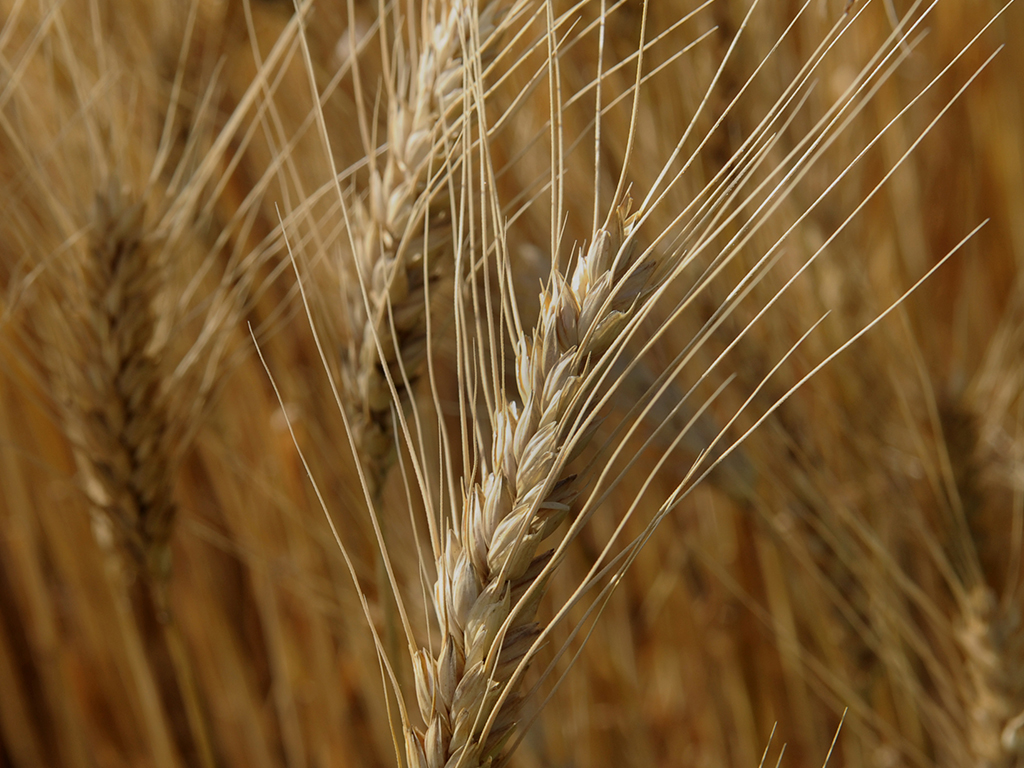
Scientists with the USDA's Agricultural Research Service in Manhattan have found a wheat gene that, when 'shut off', results in resistance to Fusarium head blight, a crippling fungal disease. | Download this photo.
Twenty-year study nets resistance to Fusarium head blight
Scientists confirm new ally in battling a crippling wheat disease
June 10, 2019
MANHATTAN, Kan. – Kansas State University researchers have identified a gene that will further boost efforts to develop new wheat varieties capable of resisting Fusarium head blight (FHB), a fungal disease that threatens production worldwide.
The 20-year study, which is being published this week inNature Genetics, found that a gene – known as TaHRC – plays a key role in providing resistance to FHB, also known as scab disease.
Guihua Bai, a plant molecular geneticist with the Agricultural Research Service in Manhattan and an adjunct professor in the Department of Agronomy, said the research team was able to modify the production of select proteins in wheat by shutting off the gene, thus increasing the plants’ ability to resist FHB.
“Usually, it is just the opposite,” Bai said. “The loss of gene function usually makes plants susceptible (to a given disease). We found that this gene is a susceptible gene in most wheat lines and that deleting part of the gene caused it to lose its function, and thus make the plant more resistant.”
The finding is significant in scientists’ quest to find resistance to FHB, which can cause crippling losses to wheat production. From 1993 to 2001, the disease caused $7.6 billion in losses in U.S. wheat fields, and more recently – in 2015 – the Kansas wheat crop was hit by an estimated 3.4 percent yield loss due to FHB.
Minnesota farmers have been hit especially hard. Since the 1990s, officials estimate $2.7 billion in losses for that state’s wheat and barley industries due to FHB, causing many growers to file bankruptcy.
“This disease will increase in frequency if weather conditions are wet and warm during the flowering stage,” Bai said. “We also know that the pathogen will grow in corn debris. The possibility of FHB increases in areas where corn is grown in a no-till situation where debris is left on the surface of soil.”
In addition to causing substantial production losses, FHB can cause a mycotoxin called deoxynivalenol that can cause sickness in humans and animals when healthy wheat mixes with infected seeds, according to Bai.
The K-State scientists think the TaHRC gene, previously called Fhb1, will provide the best resistance to FHB. It was initially found in a Chinese line and was introduced to U.S. wheat breeding programs more than 30 years ago.
“However, it had never been incorporated into U.S. hard winter wheat varieties through conventional breeding due to poor adaptation from its original Chinese parents,” Bai said.
“In the past decade, our lab successfully moved the gene into 16 U.S. hard winter wheat cultivars from breeding programs in the Great Plains, including several cultivars from Kansas. These improved lines with the gene are being used as parents in Great Plains breeding programs, so this gene will be in hard winter wheat varieties in the next few years.”
Incorporating resistance by directly shutting off the TaHRC gene will take additional time, Bai said, but that process has already started. The natural variant of TaHRC is available in the Chinese line already being used for resistance.
“We developed a diagnostic marker based on the gene sequence, and breeders can now accurately select the gene using the DNA marker,” Bai said. “That means breeders can easily incorporate the new resistance through traditional breeding with the aid of DNA marker technology.”
The research was conducted through a collaboration between Kansas State University and the USDA’s Agricultural Research Service. In addition to Bai, the authors of the study published in Nature Genetics include Paul St. Amand, a plant geneticist with the USDA-ARS; and a Kansas State University team in the departments of agronomy and plant pathology that includes Zhenqi Su, Amy Bernardo, Bin Tian, Hui Chen, Harold Trick and several visiting scientists.
The full paper is available online.

